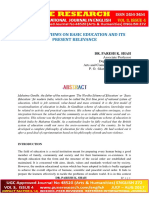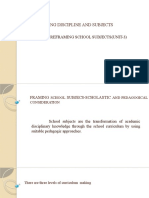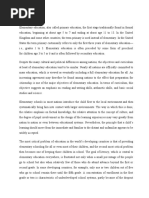Bloom Educational Implication
Uploaded by
Bernard MartinBloom Educational Implication
Uploaded by
Bernard MartinBlooms taxonomy
Bloooms taxonomy refers to a classification of the different learning objectives. It was first presented in 1956, but many changes were later added to the initial classification.
Domains
Bloom classifies educational objectives into three domains, namely: 1. the affective domain, 2. the psychomotor domain, 3. the cognitive domain. Bloom focused on the cognitive domain leaving experts to identify the categories for the other domains.
The cognitive domain
The cognitive domain refers to categories related to knowledge, comprehension, and critical thinking of a particular topic. Bloom classified these categories into six levels, moving through the lowest order processes to the highest:
Knowledge
Recalling facts, terms, basic concepts and answers. Verbs: arrange, define, duplicate, label, list, memorize, name, order, recognize, relate, recall, repeat, reproduce, state.
Comprehension
Demonstrative understanding of facts and ideas by organizing, comparing, translating, interpreting, giving descriptions, and stating main ideas. Verbs: classify, describe, discuss, explain, express, identify, indicate, locate, recognize, report, restate, review, select, translate.
Application
Using new knowledge. Applying acquired knowledge, facts, techniques and rules in a different way. Verbs: apply, choose, demonstrate, dramatize, employ, illustrate, interpret, operate, practice, schedule, sketch, solve, use, write.
Analysis
Examine and break information into parts.
Verbs: analyze, appraise, calculate, categorize, compare, contrast, criticize, differentiate, discriminate, distinguish, examine, experiment, question, test.
Synthesis
Assemble information together in a different way by combining elements in a new pattern or proposing alternative solutions. Verbs: arrange, assemble, collect, compose, construct, create, design, develop, formulate, manage, organize, plan, prepare, propose, set up, write.
Evaluation
Assessing value, making judgments about information, validity of ideas or quality of work. Verbs: appraise, argue, assess, attach, choose compare, defend estimate, judge, predict, rate, core, select, support, value, evaluate.
Affective domain
The target in the affective domain is awareness and growth in attitudes, emotion, and feelings emotional reaction and ability to feel another living things pain or joy. Five levels are identified in the affective domain moving through the lowest order processes to the highest:
Receiving
The lowest level; the student passively pays attention. Without this level no learning can occur.
Responding
Not only does the student attend the learning process but also responds and participates in some way.
Valuing
Seeing worth in new information
Organizing
Fitting the new information into existing schema and deciding how the new information makes sense for you
Characterizing
Making the new information part of your schema and exhibiting new behavior, attitude or belief
Psychomotor domain
The Psychomotor Domain is skill based and refers to the learning of skills. Physical skills are the ability to move, act, or manually manipulate the body to perform a physical movement. There are threes levels in the psychomotor domain according to RH Dave (1967)
Imitation:
Copy action of another
Manipulation:
Reproduce activity from instructions
Develop Precision:
Execute skill reliably, independent of help
Articulation:
Adapt and integrate expertise to satisfy a non-standard objective
Naturalization:
Automated, unconscious mastery of activity and related skills at strategic level
Implications
Educational implications of Blooms taxonomy include the following:
Blooms taxonomy provides a universally effective strategy for creating all type of content to impart learning. The taxonomy helps teachers make decisions about the classification of content. Blooms taxonomy also helps teachers map content to tasks that students need to perform. Blooms taxonomy guides teachers to develop higher levels of thinking process for critical thinking or creative thinking. Using the taxonomy a teacher develops questions or projects that require the development of thinking and reflection from the knowledge level to the evaluation level.
A teacher or a syllabus designer designs a curriculum as well as classroom assignment using Blooms taxonomy to advance the learning process from recalling learning materials to higher level of thinking. A teacher creates class activities based on Blooms Taxonomy.
You might also like
- IGNOU Tentative Date Sheet For December, 2019 Term-End ExaminationNo ratings yetIGNOU Tentative Date Sheet For December, 2019 Term-End Examination7 pages
- The Insight Model of Teaching (Plato) .: Submitted by Anisha K K Roll No.12No ratings yetThe Insight Model of Teaching (Plato) .: Submitted by Anisha K K Roll No.1215 pages
- Right To Education and No Detention PolicyNo ratings yetRight To Education and No Detention Policy8 pages
- Ganpat Vidyalay: Pre-Primary/Primary/A M Patel Sec/Hi-Sec (Sci/Com)No ratings yetGanpat Vidyalay: Pre-Primary/Primary/A M Patel Sec/Hi-Sec (Sci/Com)4 pages
- What Are The Nature and Principles of Inclusive EducationNo ratings yetWhat Are The Nature and Principles of Inclusive Education4 pages
- Flander's Interaction (KD 1.2.3 2nd Half Unit 5)No ratings yetFlander's Interaction (KD 1.2.3 2nd Half Unit 5)10 pages
- National Curriculum Framework For Teacher Education 12.5.22No ratings yetNational Curriculum Framework For Teacher Education 12.5.2217 pages
- Teaching Skill: 1. Skill of Introduction of LessonNo ratings yetTeaching Skill: 1. Skill of Introduction of Lesson15 pages
- Role of Cinema and Television in AdolescenceNo ratings yetRole of Cinema and Television in Adolescence11 pages
- Nature of Classroom Discourse: Prepared By-Debasmita GhoshNo ratings yetNature of Classroom Discourse: Prepared By-Debasmita Ghosh10 pages
- MEANING OF HYPOTHESIS By: - Suneha Khajuria M.Ed StudentNo ratings yetMEANING OF HYPOTHESIS By: - Suneha Khajuria M.Ed Student10 pages
- Meaning, Nature and Scope of Curriculum, Relationship Between Curriculum and SyllabiNo ratings yetMeaning, Nature and Scope of Curriculum, Relationship Between Curriculum and Syllabi9 pages
- The Assesment of Personality of A Child Using Case Study MeathodNo ratings yetThe Assesment of Personality of A Child Using Case Study Meathod8 pages
- Gandhiji'S Views On Basic Education and Its Present RelevanceNo ratings yetGandhiji'S Views On Basic Education and Its Present Relevance6 pages
- Implementing Right To Education: Issues and ChallengesNo ratings yetImplementing Right To Education: Issues and Challenges7 pages
- Equity and Excellence: Glimpses From Secondary Education of IndiaNo ratings yetEquity and Excellence: Glimpses From Secondary Education of India9 pages
- Unit 1: Pedagogic Practice and Process of LearningNo ratings yetUnit 1: Pedagogic Practice and Process of Learning25 pages
- Research Paper - Attitude Towards 2 Year B.ed., ProgrammeNo ratings yetResearch Paper - Attitude Towards 2 Year B.ed., Programme7 pages
- Present Scenario of Elementary Education in UK, USA, Japan and NetherlandsNo ratings yetPresent Scenario of Elementary Education in UK, USA, Japan and Netherlands17 pages
- Resource Management - Human Resource Material Resource and Financial Resource ManagementNo ratings yetResource Management - Human Resource Material Resource and Financial Resource Management6 pages
- Levels of Education Planning in Pakistan Book Allama IqbalNo ratings yetLevels of Education Planning in Pakistan Book Allama Iqbal210 pages
- Simulated Teaching: Inggy Yuliani Pribady 0805980 (15 OCTOBER 2008)83% (6)Simulated Teaching: Inggy Yuliani Pribady 0805980 (15 OCTOBER 2008)5 pages
- Activity Centered Education - John DeweyNo ratings yetActivity Centered Education - John Dewey18 pages
- Unit 3 - Herbartian Approach & Format of A Lesson PlanNo ratings yetUnit 3 - Herbartian Approach & Format of A Lesson Plan17 pages
- Governance and the Three Arms of Government in Sierra LeoneFrom EverandGovernance and the Three Arms of Government in Sierra LeoneNo ratings yet
- Handbook of Research on TeachingFrom EverandHandbook of Research on TeachingCourtney BellNo ratings yet
- Progressive Education In Nepal: The Community Is the CurriculumFrom EverandProgressive Education In Nepal: The Community Is the CurriculumNo ratings yet
- Sumapa Bata Elementary School 6 Bernard Frederick C. Martin MathematicsNo ratings yetSumapa Bata Elementary School 6 Bernard Frederick C. Martin Mathematics20 pages
- First Grading Period S.Y. 2013-2014 (Subject) (Grade) Most LearnedNo ratings yetFirst Grading Period S.Y. 2013-2014 (Subject) (Grade) Most Learned1 page
- I. Write The Letter of The Correct AnswerNo ratings yetI. Write The Letter of The Correct Answer3 pages
- Monthly Accomplishment Report: September 2013No ratings yetMonthly Accomplishment Report: September 20132 pages
- Class 9 Mathematics Chapter Wise Topic Wise Notes Chapter 1 Number SystemNo ratings yetClass 9 Mathematics Chapter Wise Topic Wise Notes Chapter 1 Number System85 pages
- Calamba City Senior High School: Learning Area Grade Level Teacher Semester Date/Time Quarter I. ObjectivesNo ratings yetCalamba City Senior High School: Learning Area Grade Level Teacher Semester Date/Time Quarter I. Objectives3 pages
- The Hermeneutics of Faith and The Hermeneutics of SuspicionNo ratings yetThe Hermeneutics of Faith and The Hermeneutics of Suspicion28 pages
- Ethical Theory An Anthology Blackwell Philosophy Anthologies PDFNo ratings yetEthical Theory An Anthology Blackwell Philosophy Anthologies PDF2 pages
- Criteria For Oral Activity: Maximum Score: 20 PointsNo ratings yetCriteria For Oral Activity: Maximum Score: 20 Points3 pages
- 2023 AMP University Challenge Overview 6 Pages v1.0No ratings yet2023 AMP University Challenge Overview 6 Pages v1.06 pages
- Teaching Strategy: Return Demonstration Broad Overview of StrategyNo ratings yetTeaching Strategy: Return Demonstration Broad Overview of Strategy4 pages
- F2 Writing Exercise (Speech_pandemic) (6)No ratings yetF2 Writing Exercise (Speech_pandemic) (6)7 pages
- Do Not Go for an Interview Before Knowing These 10 QuestionsNo ratings yetDo Not Go for an Interview Before Knowing These 10 Questions5 pages
- Montessori Method For Orienting and MotiNo ratings yetMontessori Method For Orienting and Moti117 pages
- The Rooting of Peoples and The Territorialization of National Identity Among Scholars and RefugeesNo ratings yetThe Rooting of Peoples and The Territorialization of National Identity Among Scholars and Refugees22 pages
- IGNOU Tentative Date Sheet For December, 2019 Term-End ExaminationIGNOU Tentative Date Sheet For December, 2019 Term-End Examination
- The Insight Model of Teaching (Plato) .: Submitted by Anisha K K Roll No.12The Insight Model of Teaching (Plato) .: Submitted by Anisha K K Roll No.12
- Ganpat Vidyalay: Pre-Primary/Primary/A M Patel Sec/Hi-Sec (Sci/Com)Ganpat Vidyalay: Pre-Primary/Primary/A M Patel Sec/Hi-Sec (Sci/Com)
- What Are The Nature and Principles of Inclusive EducationWhat Are The Nature and Principles of Inclusive Education
- National Curriculum Framework For Teacher Education 12.5.22National Curriculum Framework For Teacher Education 12.5.22
- Teaching Skill: 1. Skill of Introduction of LessonTeaching Skill: 1. Skill of Introduction of Lesson
- Nature of Classroom Discourse: Prepared By-Debasmita GhoshNature of Classroom Discourse: Prepared By-Debasmita Ghosh
- MEANING OF HYPOTHESIS By: - Suneha Khajuria M.Ed StudentMEANING OF HYPOTHESIS By: - Suneha Khajuria M.Ed Student
- Meaning, Nature and Scope of Curriculum, Relationship Between Curriculum and SyllabiMeaning, Nature and Scope of Curriculum, Relationship Between Curriculum and Syllabi
- The Assesment of Personality of A Child Using Case Study MeathodThe Assesment of Personality of A Child Using Case Study Meathod
- Gandhiji'S Views On Basic Education and Its Present RelevanceGandhiji'S Views On Basic Education and Its Present Relevance
- Implementing Right To Education: Issues and ChallengesImplementing Right To Education: Issues and Challenges
- Equity and Excellence: Glimpses From Secondary Education of IndiaEquity and Excellence: Glimpses From Secondary Education of India
- Unit 1: Pedagogic Practice and Process of LearningUnit 1: Pedagogic Practice and Process of Learning
- Research Paper - Attitude Towards 2 Year B.ed., ProgrammeResearch Paper - Attitude Towards 2 Year B.ed., Programme
- Present Scenario of Elementary Education in UK, USA, Japan and NetherlandsPresent Scenario of Elementary Education in UK, USA, Japan and Netherlands
- Resource Management - Human Resource Material Resource and Financial Resource ManagementResource Management - Human Resource Material Resource and Financial Resource Management
- Levels of Education Planning in Pakistan Book Allama IqbalLevels of Education Planning in Pakistan Book Allama Iqbal
- Simulated Teaching: Inggy Yuliani Pribady 0805980 (15 OCTOBER 2008)Simulated Teaching: Inggy Yuliani Pribady 0805980 (15 OCTOBER 2008)
- Unit 3 - Herbartian Approach & Format of A Lesson PlanUnit 3 - Herbartian Approach & Format of A Lesson Plan
- Governance and the Three Arms of Government in Sierra LeoneFrom EverandGovernance and the Three Arms of Government in Sierra Leone
- Progressive Education In Nepal: The Community Is the CurriculumFrom EverandProgressive Education In Nepal: The Community Is the Curriculum
- Sumapa Bata Elementary School 6 Bernard Frederick C. Martin MathematicsSumapa Bata Elementary School 6 Bernard Frederick C. Martin Mathematics
- First Grading Period S.Y. 2013-2014 (Subject) (Grade) Most LearnedFirst Grading Period S.Y. 2013-2014 (Subject) (Grade) Most Learned
- Class 9 Mathematics Chapter Wise Topic Wise Notes Chapter 1 Number SystemClass 9 Mathematics Chapter Wise Topic Wise Notes Chapter 1 Number System
- Calamba City Senior High School: Learning Area Grade Level Teacher Semester Date/Time Quarter I. ObjectivesCalamba City Senior High School: Learning Area Grade Level Teacher Semester Date/Time Quarter I. Objectives
- The Hermeneutics of Faith and The Hermeneutics of SuspicionThe Hermeneutics of Faith and The Hermeneutics of Suspicion
- Ethical Theory An Anthology Blackwell Philosophy Anthologies PDFEthical Theory An Anthology Blackwell Philosophy Anthologies PDF
- Criteria For Oral Activity: Maximum Score: 20 PointsCriteria For Oral Activity: Maximum Score: 20 Points
- 2023 AMP University Challenge Overview 6 Pages v1.02023 AMP University Challenge Overview 6 Pages v1.0
- Teaching Strategy: Return Demonstration Broad Overview of StrategyTeaching Strategy: Return Demonstration Broad Overview of Strategy
- Do Not Go for an Interview Before Knowing These 10 QuestionsDo Not Go for an Interview Before Knowing These 10 Questions
- The Rooting of Peoples and The Territorialization of National Identity Among Scholars and RefugeesThe Rooting of Peoples and The Territorialization of National Identity Among Scholars and Refugees



































































































